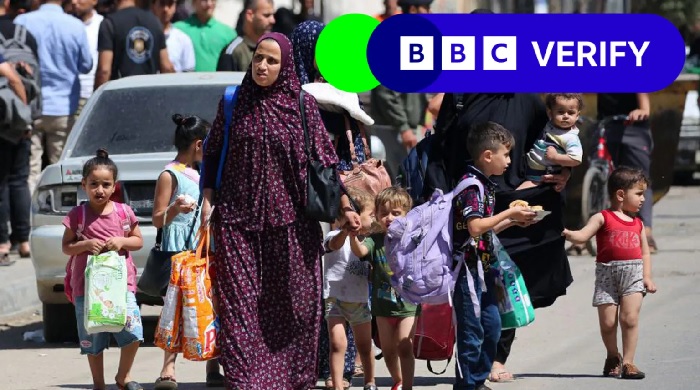More than 40,000 Palestinians have been killed as a result of Israeli military action in Gaza since the 7 October Hamas-led attack on Israel, the Hamas-run health ministry says.
That number - 40,005 on Thursday - equates to about 1.7% of the 2.3 million population of the territory - another sobering indication of the human cost of the war.
Alongside the fatalities, satellite image analysis suggests nearly 60% of buildings in Gaza have been damaged or destroyed since the beginning of the war.
In the past few months, the southern city of Rafah has suffered the most damage, imagery shows.
The health ministry’s figures for the number of people killed do not differentiate between civilians and fighters.
However, its breakdown of identified reported fatalities says a majority are children, women or elderly people.
This month, Israel’s military told the BBC that more than 15,000 terrorists had been killed during the war.
International journalists, including the BBC, are blocked by Israel from entering Gaza independently, so are unable to verify figures from either side.
In the past, figures from the Gaza Ministry of Health (MoH) were widely used in times of conflict and seen as reliable by the UN and international institutions.
It only counted deaths registered in hospitals with these entered in a centralised system along with names, identity numbers and other details.
However, by late last year the MoH was unable to function effectively with overflowing mortuaries, fighting in and around hospitals and poor internet and phone connectivity.
The Hamas Government Media Office (GMO) in Gaza began publishing numbers of deaths including reports given in “reliable media”.
UN agencies started to incorporate this into their data breakdowns as well as MoH figures when updates were available.
More recently, Gaza’s MoH has begun to incorporate those reported as killed in the war including by family members online in its overall tally.
However, it also counts separately the number of unidentified bodies among the total number killed.
The UN now quotes these figures, with officials attributing them and stressing that their Gaza teams cannot independently verify them due to the conditions on the ground and the high volume of fatalities.
Israel has consistently questioned the credibility of the information. In May, the Foreign Minister Israel Katz described it as “fake data from a terrorist organisation”.
Several experts have said the actual number of people killed as a direct result of the war in Gaza is likely to be far higher, with local officials estimating that about 10,000 bodies remain under the rubble of buildings hit by Israeli air strikes.
And even with a halt in fighting, researchers point out that in addition to the number of people killed as a direct result of the war, many more could die from indirect causes, such as disease and hunger.
Ultimately when the war ends, efforts to recover bodies and trace the missing should allow a clearer idea to emerge of the number killed, including a figure for combatants. The UN and rights groups, as well as the Israeli military, can be expected to carry out their own investigations.
Satellite image analysis suggests that around 59.3% of buildings in Gaza have been damaged or destroyed since the beginning of the war.
The damage analysis, carried out by Corey Scher of City University of New York and Jamon Van Den Hoek of Oregon State University, compares images to reveal sudden changes in the height or structure of buildings.
The southern city of Rafah has sustained the highest rise in damaged buildings since March, according to the expert analysis.
The majority of the destruction came after Israel launched an offensive on the city on 6 May. The military says that taking control of the area and eliminating the remaining Hamas battalions is crucial to achieving its war aims.
In satellite imagery analysed by BBC Verify, large swathes of the city can be seen to be left in ruins - particularly around the border with Egypt and neighbourhoods to the north and south.
Social media videos verified by the BBC and footage shared by Israel’s military shows that areas across Rafah have been damaged or destroyed by aerial bombardment as well as demolition by Israeli forces on the ground.
In the image below we see a large section of cleared buildings immediately adjacent to the border.

